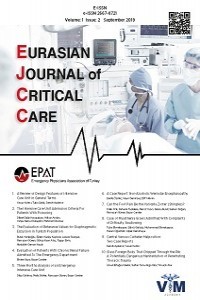Can Routine Blood Tests Be Used To Predict The Prognosis of COVID-19 Patients Using Antithrombotic Drugs
Can Routine Blood Tests Be Used To Predict The Prognosis of COVID-19 Patients Using Antithrombotic Drugs
COVİD-19, Antithrombotic, Prognosis, Biomarkers,
___
- 1. Raskob GE, Angchaisuksiri P, Blanco AN, et al. Thrombosis: a major contributor to global disease burden. Arterioscler Thromb Vasc Biol. 2014; 34(11): 2363-71. doi: 10.1161/ATVBAHA.114.304488.
- 2. Goeijenbier M, van Wissen M, van de Weg C, et al. Review: viral infections and mechanisms of thrombosis and bleeding. J Med Virol. 2012; 84(10): 1680-96. doi: 10.1002/jmv.23354.
- 3. Lodigiani C, Iapichino G, Carenzo L, et al. Venous and arterial thromboembolic complications in COVID-19 patients admitted to an academic hospital in Milan, Italy. Thromb Res. 2020; 191: 9-14. doi: 10.1016/j.thromres.2020.04.024
- 4. Klok FA, Kruip MJHA, van der Meer NJM, et al. Incidence of thrombotic complications in critically ill ICU patients with COVID 19. Thromb Res. 2020; 191: 145-7. doi: 10.1016/j.thromres.2020
- 5. Lim W, Meade M, Lauzier F, et al. Failure of anticoagulant thromboprophylaxis: risk factors in medical-surgical critically ill patients. Crit Care Med. 2015; 43(2): 401-10. doi: 10.1097/CCM.0000000000000713
- 6. Thachil J, Tang N, Gando S, et al. ISTH interim guidance on recognition and management of coagulopathy in COVID-19. J Thromb Haemost. 2020; 18(5): 1023-6. doi: 10.1111/jth.14810
- 7. Iba T, Nisio MD, Levy JH, et al. New criteria for sepsis-induced coagulopathy (SIC) following the revised sepsis definition: a retrospective analysis of a nationwide survey. BMJ Open. 2017; 27; 7(9): 017046. doi:10.1136/bmjopen-2017-017046
- 8. Zhou F, Yu T, Du R, et al. Clinical course and risk factors for mortality of adult inpatients with COVID-19 in Wuhan, China: a retrospective cohort study. Lancet. 2020; 28; 395(10229): 1054-62. doi:10.1016/S0140-6736(20)30566-3
- 9. Middeldorp S, Coppens M, van Haaps TF, et al. Incidence of venous thromboembolism in hospitalized patients with COVID-19. Comparative Study. J Thromb Haemost. 2020; 18(8): 1995-2002. doi: 10.1111/jth.14888.
- 10. Murray MK, Bode K, Whittaker P. Gender-specifc associations between coronary heart disease and other chronic diseases: crosssectional evaluation of national survey data from adult residents of Germany. J Geriatr Cardiol. 2019; 16(9): 663–70. doi: 10.11909/j.issn.1671-5411.2019.09.004.
- 11. Flaczyk A, Rosovsky RP, Reed CT, et al. Comparison of published guidelines for management of coagulopathy and thrombosis in critically ill patients with COVID 19: implications for clinical practice and future investigations. Crit Care. 2020; 16; 24(1): 559. doi: 10.1186/s13054-020-03273-y
- 12. Paranjpe I, Fuster V, Lala A, et al. Association of treatment dose anticoagulation with in-hospital survival among hospitalized patients with COVID-19. J Am Coll Cardiol. 2020; 7; 76(1): 122-4. doi: 10.1016/j.jacc.2020.05.001.
- 13. Siegal DM, Barnes GD, Langlois NJ, et al. A toolkit for the collection of thrombosis-related data elements in COVID-19 clinical studies. Blood Adv. 2020; 22; 4(24): 6259-73. doi: 10.1182/bloodadvances.2020003269.
- 14. Al-Samkari H, Karp Leaf RS, Dzik WH, et al. COVID and coagulation: bleeding and thrombotic manifestations of SARS-CoV2 infection. Blood. 2020; 23; 136(4): 489-500. doi: 10.1182/blood.2020006520.
- 15. Henry BM, Aggarwal G, Wong J, et al. Lactate dehydrogenase levels predict coronavirus disease 2019 (COVID-19) severity and mortality: A pooled analysis. Am J Emerg Med. 2020; 38(9): 1722–6. doi: 10.1016/j.ajem.2020.05.073.
- 16. Zhang ZL, Hou YL, Li DT, Li FZ. Laboratory findings of COVID-19: a systematic review and meta-analysis. Scand. J Clin Lab Invest. 2020; 80(6): 441-7. doi: 10.1080/00365513.2020.1768587.
- 17. Long H, Nie L, Xiang X, et al. D-Dimer and Prothrombin Time Are the Significant Indicators of Severe COVID-19 and Poor Prognosis. Biomed Res Int. 2020: 6159720. doi: 10.1155/2020/6159720.
- 18. Yang AP, Liu JP, Tao WQ, Li HM. The diagnostic and predictive role of NLR, d-NLR and PLR in COVID-19 patients. Int Immunopharmacol. 2020; 84: 106504. doi: 10.1016/j.intimp.2020.106504.
- 19. Lippi G, Lavie CJ, Sanchis-Gomar F. Cardiac troponin I in patients with coronavirus disease 2019 (COVID-19): evidence from a meta-analysis. Prog Cardiovasc Dis. 2020; 63(3): 390-391. doi: 10.1016/j.pcad.2020.03.001.
- 20. Velavan TP, Meyer CG. Mild versus severe COVID-19: laboratory markers. Int J Infect Dis. 2020; 95: 304-7. doi: 10.1016/j.ijid.2020.04.061.
- 21. Sivaloganathan H, Ladikou EE, Chevassut T. COVID-19 mortality in patients on anticoagulants and antiplatelet agents. Br J Haematol. 2020; 190(4): 192-5. doi: 10.1111/bjh.16968.
- 22. Egan G, Hughes CA, Ackman ML. Drug interactions between antiplatelet or novel oral anticoagulant medications and antiretroviral medications. Ann Pharmacother. 2014; 48(6): 734-40. doi: 10.1177/1060028014523115.
- 23. Agarwal S, Agarwal SK. Lopinavir-Ritonavir in SARS-CoV-2 Infection and Drug-Drug Interactions with Cardioactive Medications. Cardiovasc Drugs Ther. 2020; 12; 1-14. doi: 10.1007/s10557-020-07070-1.
- 24. Guan WJ, Liang WH, Zhao Y, et al. Comorbidity and its impact on 1590 patients with Covid-19 in China: a nationwide analysis. Eur Respir J. 2020; 55(5): 2000547. doi: 10.1183/13993003.00547-2020
- Başlangıç: 2019
- Yayıncı: Acil Tıp Uzmanları Derneği
D-Dimer Levels and Prognostic Features in Pulmonary Embolism
Burak KURTOĞLU, Halil İbrahim ÇIKRIKLAR, Vahide Aslıhan DURAK, Issa OMAR, Ahmet Münir YILMAZ, Sümeyye Tuğba SARKI CANDER, Erol ARMAGAN
Causes and Outcomes of Childhood Trauma with GCS Below 9
Changiz GHOLİPOURİ, Samad SHAMS VAHDATİ, Parham MAROUFİ, Aytak KHABBAZ, Naeimeh HOSSEİNZADEH, Pouya ABBASGHOLİZADEH
Bibliometric Analysis of Studies on Mean Platelet Volume (MPV) in the Web of Science Database
Hasan GÜMÜŞBOĞA, Muhammet Esat KARADUMAN, Ceren KARAKEÇİLİ, Mustafa BOĞAN
Ayça ÇALBAY, Atıf BAYRAMOĞLU, Erdem KARADENİZ
Evaluation of Nursing Home Residents Applying to The Emergency Service
Ali İhsan KİLCİ, Hakan HAKKOYMAZ, Muhammed Semih GEDİK, Levent AVSAROGULLARİ, Vesile ŞENOL, Mükerrem ALTUNTAŞ
Bahadir TASLİDERE, Ertan SONMEZ, Ayse KARATAS, Begüm SAKIN, Rümeyza KAZANCIOĞLU
Central Pontine Myelinolysis as a Result of Ideally Corrected Hyponatremia in a Post-Covid Patient
Julide GURBUZ, Bahadir TASLİDERE, Ahmet EMİN, Ertan SONMEZ
The Influence of the COVID‑19 Pandemic on Pediatric Head Trauma
